Review & Photography by Manny Manson for MPM
The crowd were already buzzing, long before a single note rang out. The Halls felt tight, almost claustrophobic with anticipation, the smell of sweat and metal filling the air. Fans had edged forward toward the barrier; you could sense that the pit already simmering like a cauldron ready to boil over. The lights dimmed, and a slow hum of anticipation rattled through the Hall’s. Then came the taped intro, “From the Nothingness With Love” eerie, atmospheric, an ominous herald that shook the floor beneath you. A smoky haze curled around the stage edges, red and violet washes cutting across the audience like warning signals.
Then they appeared. Decapitated didn’t just walk out, they materialized, Vogg in the centre, like a conductor of chaos, eyes cold, guitar ready to slice. Rafal Piotrowski stalked the front, poised, growl ready to erupt. First riff of “Cancer Culture” from Cancer Culture (2022) hit, and the pit ignited instantly. Every double kick, every machine-like staccato of Vogg’s fretwork, the low hum of bassist, it all collided in a brutal, precise wave. You could feel the vibrations in your chest, in your teeth. The first crowd surfers were cautious, tentative, but the energy fed them like fuel; soon they were flying thick and fast.
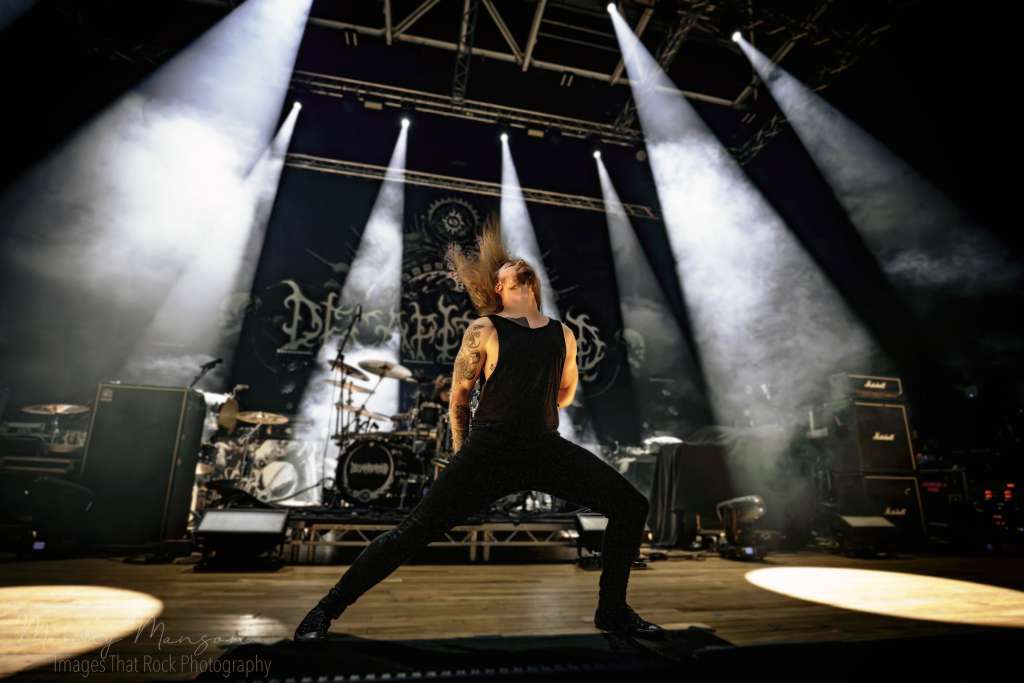
Next, “Just a Cigarette” carried that mechanical precision forward. You could see Vogg nod to the drummer mid-song, an imperceptible cue, and the breakdown hit perfectly in sync. Rafal prowled, hair lashing, each scream cutting like metal shards. The lights strobed green, red and white, haze curling in columns from the stage vents, twisting through the audience. You could almost see the band’s history in each motion, forged in Krosno, Poland in ’96, trained in the early technical death metal scene, surviving tragedy and rebuilding after Vitek’s death, now performing with that precise control that only decades of loss and rebirth can create.
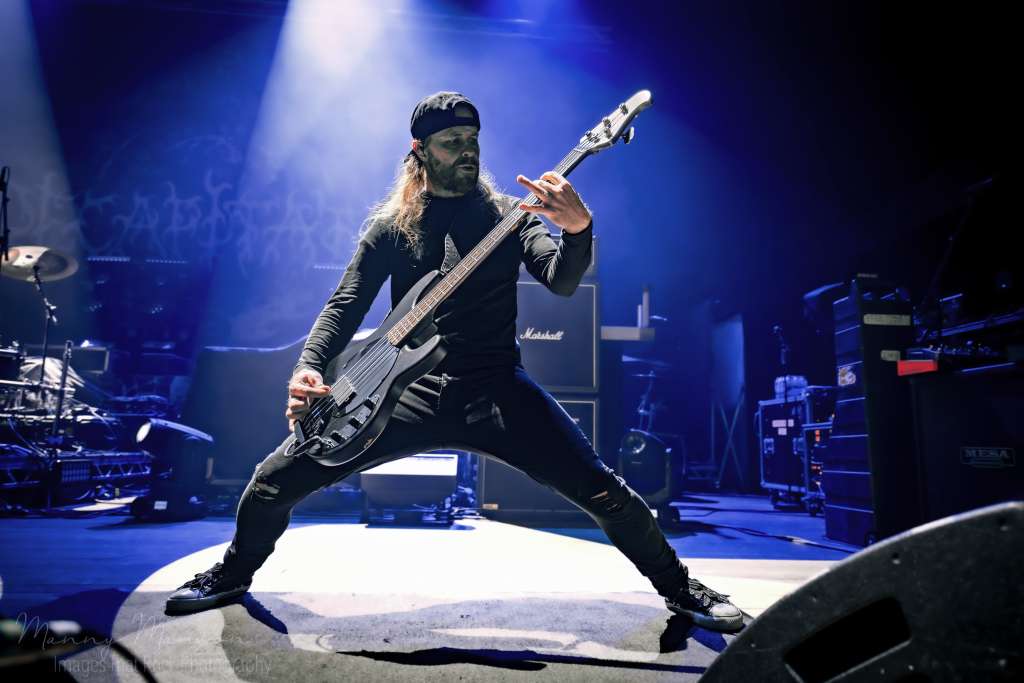
“Earth Scar” from Anticult (2017) followed, mid-tempo groove anchoring the pit’s movement. Bodies collided, shirts stuck to sweat-slicked skin, fists punching the air. The riff churned like a slow blade, sharp, methodical. Vogg and Rafal exchanged glances, tiny micro-gestures only they could see, the silent communication of a band that knows every measure, every drop, every impact. By “Spheres of Madness” (Nihility, 2002), the old fans were vocal, mouthing lyrics from memory, and the younger fans were pure chaos, bouncing, shouting, surging into each other in the growing pit. The lights shifted to full white for the iconic opening, highlighting every bead of sweat on stage, every grimace of concentration. You could feel the technicality and history mingling, a Polish band that once shocked the metal world with impossibly tight riffs in their teens, now seasoned, dominating arenas.
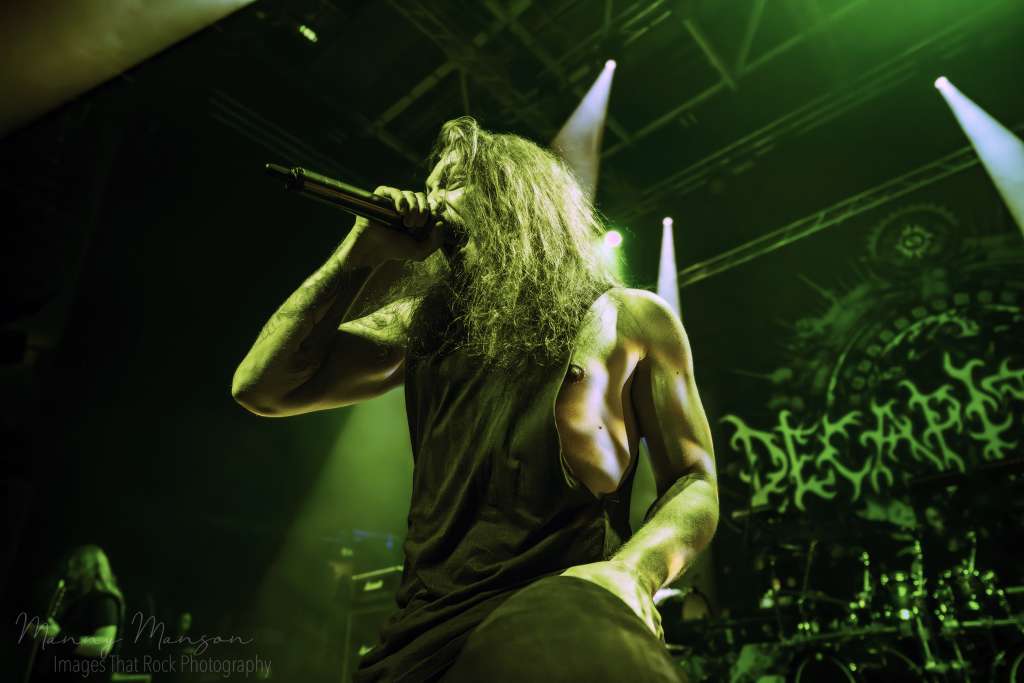
“Suicidal Space Programme” cut in with a crushing groove, smoke coiling around the lights, the heat of the them almost tangible. Rafal’s vocals carved through the room, commanding attention, Vogg’s guitar slicing clean and sharp through the fog. The pit had now become a maelstrom, crowd surfers landing in a tangle of limbs, security shifting, caught in the flow, letting bodies move as they’d been trained to do. They closed with “Iconoclast”, and the Hall’s felt every note like a wall collapsing. The final breakdowns hit, lights synchronized perfectly with the percussive accents, smoke thick, heat rising. When the final chord died, there was no immediate cheer, just a stunned moment of collective awe. Then the applause ripped through, and Decapitated stepped off like silent generals, leaving the hall trembling, the energy still raw in every bone.
The tech crew swarmed, flipping risers, swapping monitors, and as the last fog rolled out, the crowd was already leaning forward, knowing the next wave of intensity was coming. The green and blue lights of Fit For An Autopsy began to hum, and the pit, still recovering, braced for the next assault. The Hall’s barely had time to catch its breath before the first ominous growl of Fit For An Autopsy ripped through the smoke-filled stage.
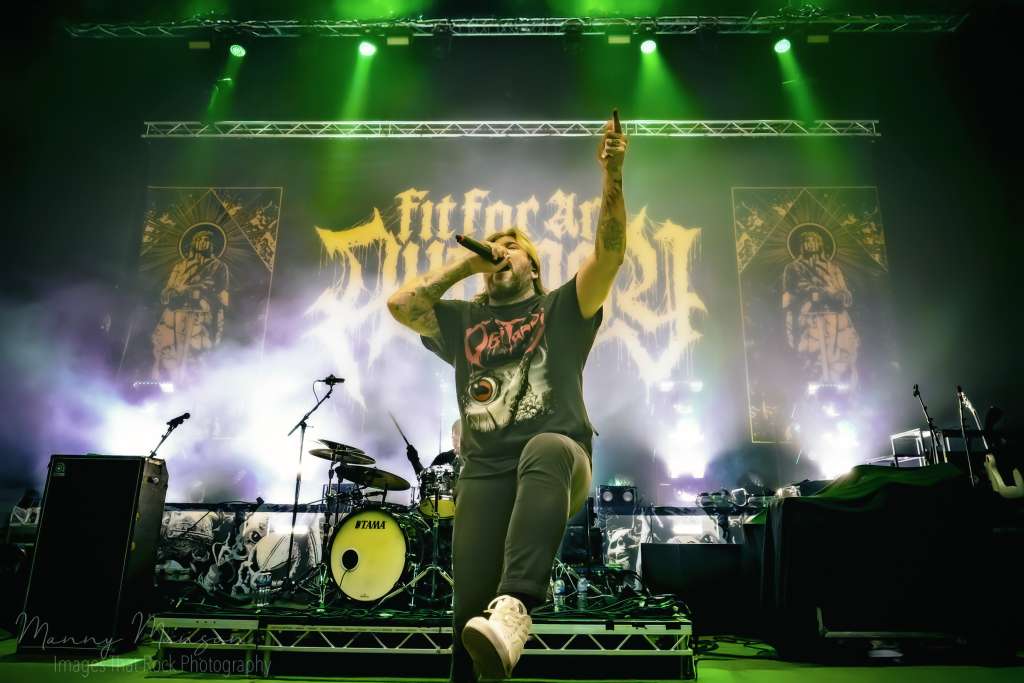
The lighting shifted from the reds and violets of Decapitated to a wash of deep green and blue, tinged with slivers of orange and red, casting jagged shadows across the walls and the eager, sweating faces of the pit. The band took the stage like predators, Joe Badolato stepping forward, eyes blazing, commanding the attention of a floor that was already thrumming with energy. From New Jersey, formed in 2008, they had carved a niche in the deathcore scene, blending crushing riffs with atmospheric layers that created a cinematic darkness in every performance.
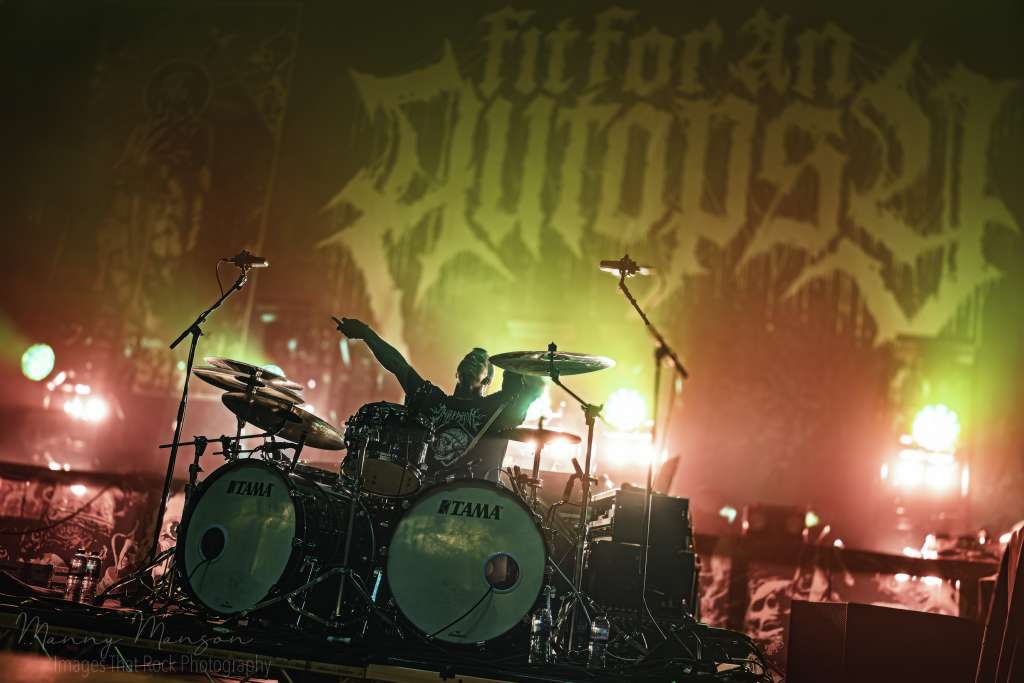
Their history is one of measured escalation, album by album: The Process of Human Extermination (2011), Absolute Hope Absolute Hell (2012), The Great Collapse (2017), up through Oh What the Future Holds (2022). Each record had refined their signature sound, oppressive, technical, yet with a melodic sensibility that gives the live show room to breathe between the blows.
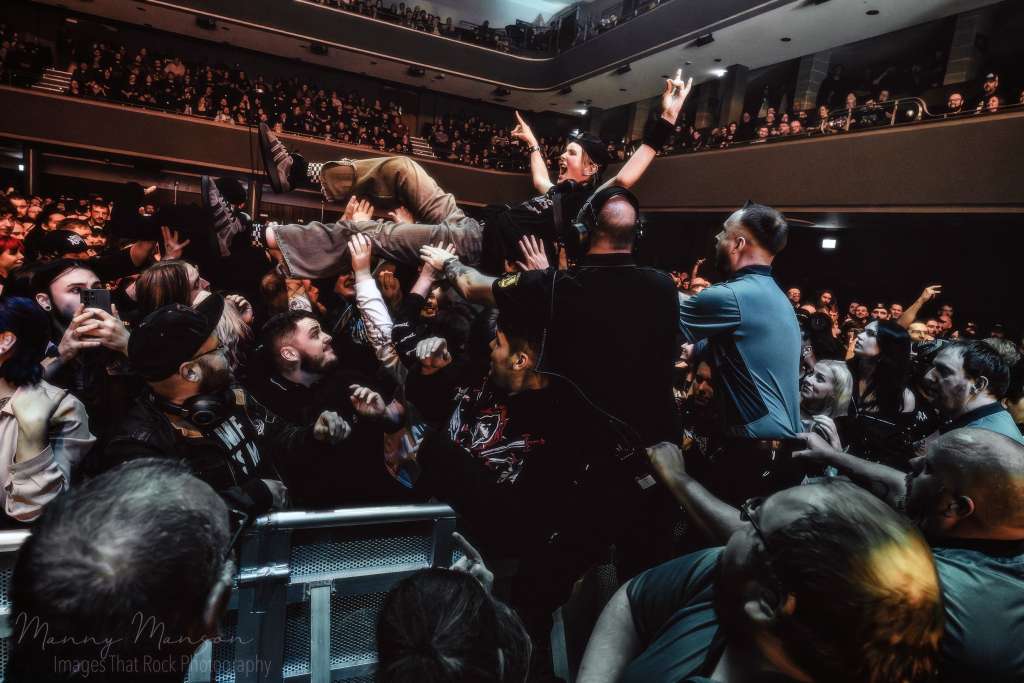
They opened with “Lower Purpose” from The Nothing That Is (2024). The riff cut like a scalpel, tight and surgical, yet somehow monumental. Each note Sheridan and Howley played seemed to echo off the ceiling, bouncing around the Hall’s, while Badolato’s guttural voice carved through it all. He prowled the stage, pausing mid-verse to gesture to the crowd, letting the audience’s own growls carry through the song’s breakdowns. Smoke hung low, swirling around the risers, the green and blue lighting picking out faces in the pit like ghostly masks. Crowd surfers started appearing thick and fast now, some cautiously at first, others hurled into the air like practiced athletes. Security moved with precise choreography, letting bodies ride the chaos, lifting some gently while bracing for the next wave.
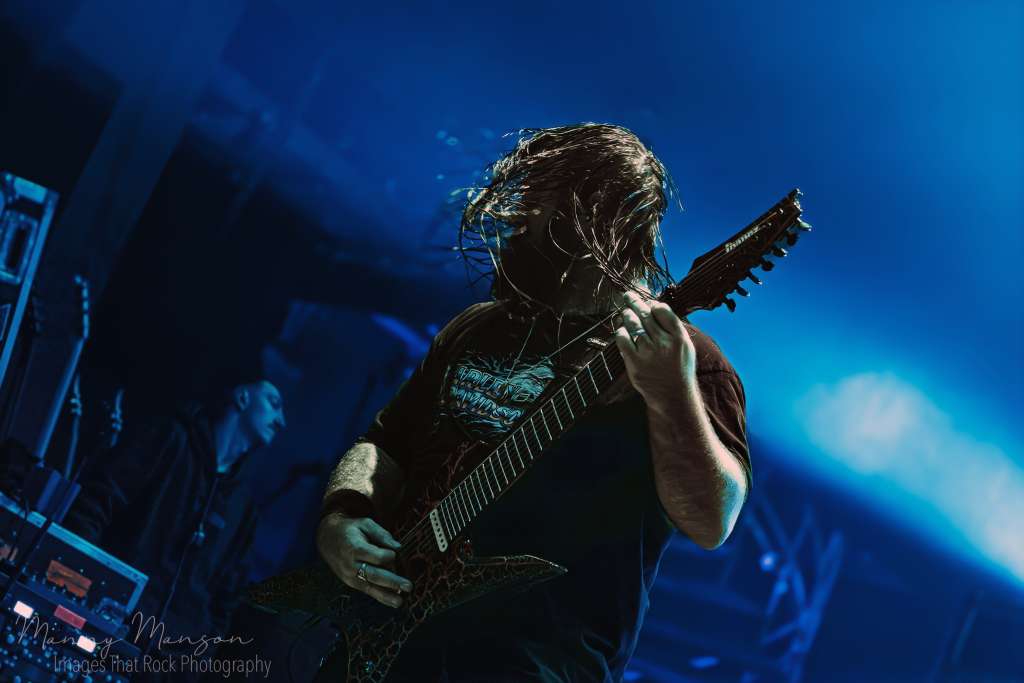
“It Comes for You” from, a stand-alone single released in September 2025, hit next, and the pit erupted. That opening riff, all chug and power, was met with a surge of movement, heads smashing, fists pumping. The band leaned into each other, tight as a unit. You could see Badolato flash a grin at Howley before launching into the chorus, a flicker of joy amid the relentless weight of the music. There was a subtle theatricality to the performance, the way the lighting cut in pulses with the riffs, the smoke swirling through green and orange beams, accentuating each moment of tension and release.
By “Hostage” from The Nothing That is, the band had fully claimed the stage. The interplay between guitarists Sheridan and Howley was mesmerising, riffs slicing, harmonics ringing, solos interweaving with relentless precision. Bass underlined the riffs with a low growl, percussion hitting like a mechanized heartbeat. Badolato foot on the wedges, leaning into the crowd at times, letting the fans’ own screams become part of the rhythm. The pit was now a churning, heaving organism, fuelled by adrenaline and fearlessness.
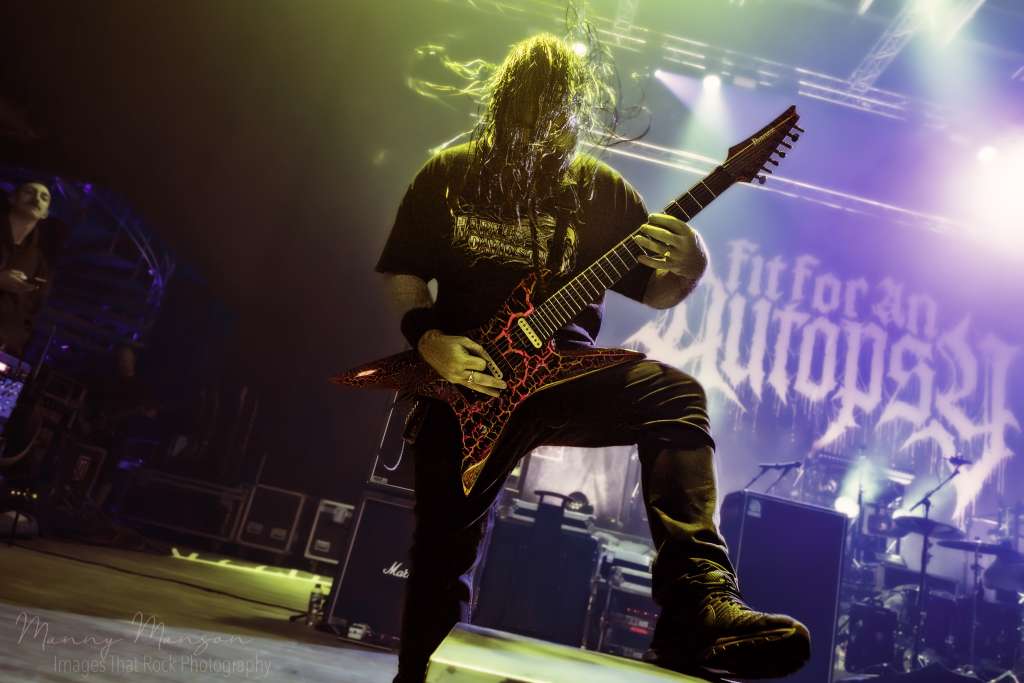
“Pandora” followed, from Oh What The Future Holds (2022), a slower, crushing track, the kind that forces the pit to sync in rhythm, step, smash, push. The lights softened slightly, smoky green and blue haze thickening, giving the impression of an otherworldly, post-apocalyptic landscape. You could see the history of the band in every movement: formed by musicians who came through the New Jersey hardcore and deathcore scenes, honing their craft, each member understanding the delicate balance between technicality and visceral impact. Their albums had always told stories, and live, the songs take on even more weight, the pit becoming a narrative of controlled chaos. The centrepiece of their set, “The Sea of Tragic Beasts” title track, rolled in next. Epic, sprawling, it’s a song built for the stage, atmospheric synth undertones layered beneath crushing guitars, drums that swell and drop, bass that shakes the floor. Badolato prowled like a general, gesturing, inviting, challenging. Crowd surfers flew thick and fast, some making it across multiple waves before being safely lowered. And to add to the excitement, a huge beach ball was cast adrift and pummelled around the excited crowd. The band’s energy was unrelenting; yet in quieter passages, the atmospheric elements of the song, minor key melodies, the moody backing textures, made you catch your breath, contrast creating even greater intensity when the breakdown slammed back in.
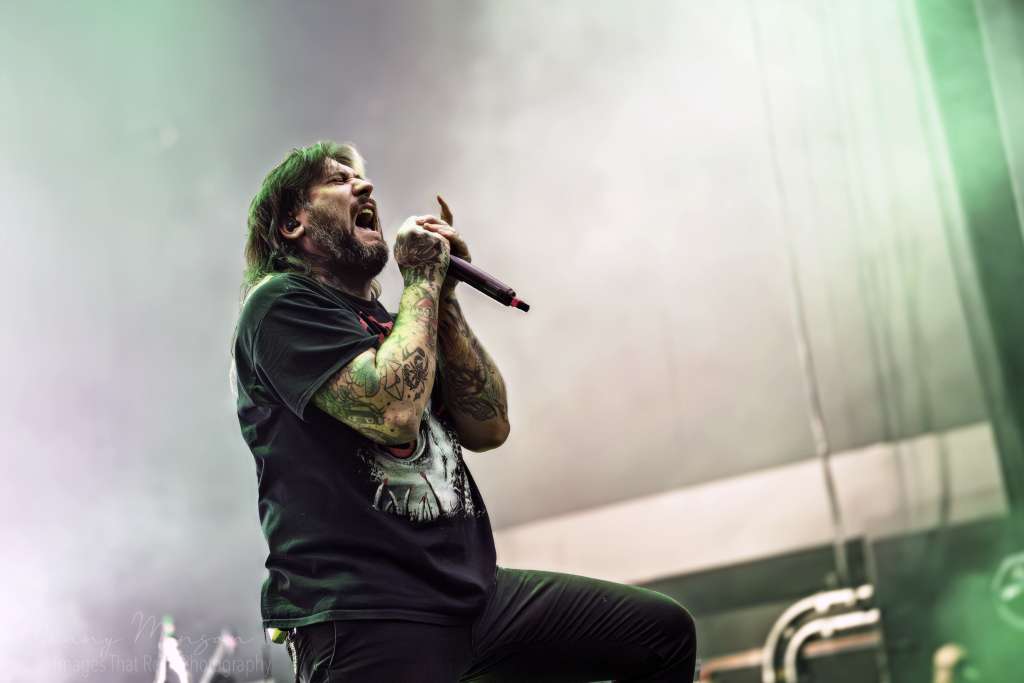
“Savior of None / Ashes of All” followed seamlessly. From The Nothing That Is (2024), these songs showed the band’s maturity, blending melody with punishing riffs. The pit was now operating like a machine, bodies moving with practiced synchronicity. Badolato and Howley shared glances mid-song, almost imperceptible, and the performance gained a precision that was thrilling to witness. The lighting switched to stark orange and red for the heavier breakdowns, smoke layering like thick fog, stage edges glowing. The audience was entirely in sync, responding to every build, release, and harmonic flourish. They closed their set with “Far From Heaven” (Oh What The Future Holds), a punishing, almost cinematic finish.
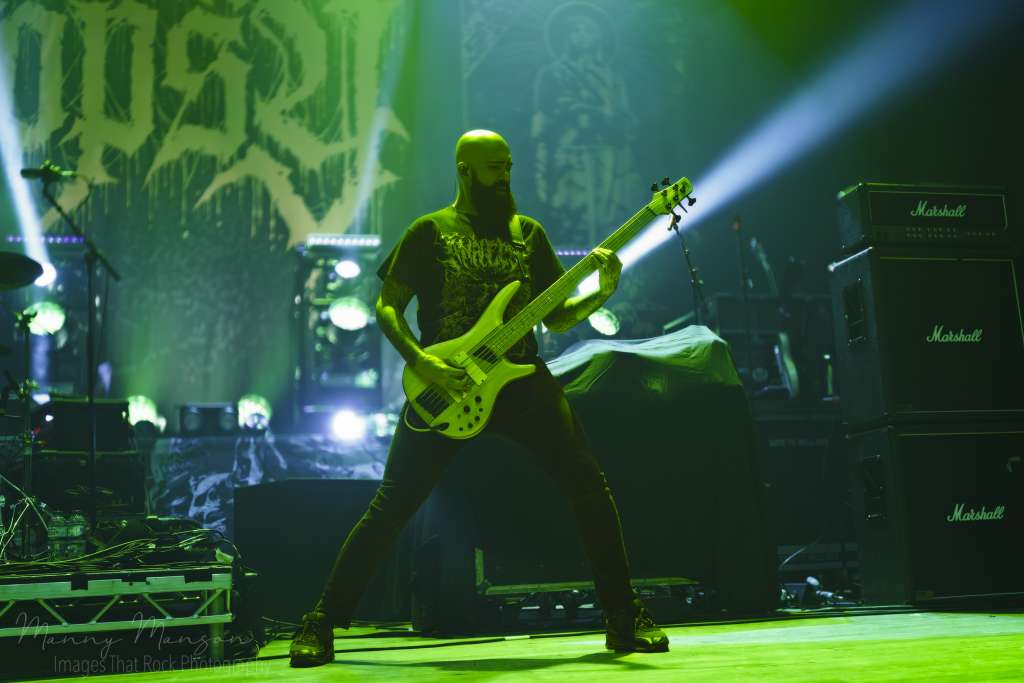
The riffs churned, drums pounding, smoke thick and curling under the coloured lights. Badolato stood centre stage, commanding the final moments, letting the last wave of energy ride out into the pit. Crowd surfers still sailed over the barrier, exhausted but exhilarated, the band feeding off the adrenaline as they concluded. You could see the journey in their faces, focus, satisfaction, the quiet pride of a group who has honed their craft over more than a decade and now owned every inch of that stage.
As the last note died, the Hall’s hummed with residual tension, the pit still heaving, fans catching their breath, sweat dripping, eyes wide from immersion. The transition began almost immediately, the smell of smoke and sweat lingering, the stage reset, drum risers swapped. The audience barely had time to settle before the low hum of Hatebreed’s taped intro began, a new wave of chaos building from the far side of the Hall’s. Fit For An Autopsy’s chapter had ended, leaving the crowd primed, restless, and ready for the next assault, the pit heaving, bodies tangled, sweat dripping, adrenaline pumping, when the first heavy strains of Accept’s “Balls to the Wall” hit through the speakers. The smoke swirled low along the floor, lights cutting jagged streaks of red and orange through the haze, and the crowd responded instantly. It was a call to arms, a warning that Jamey Jasta and his Connecticut hardcore machine were about to descend.
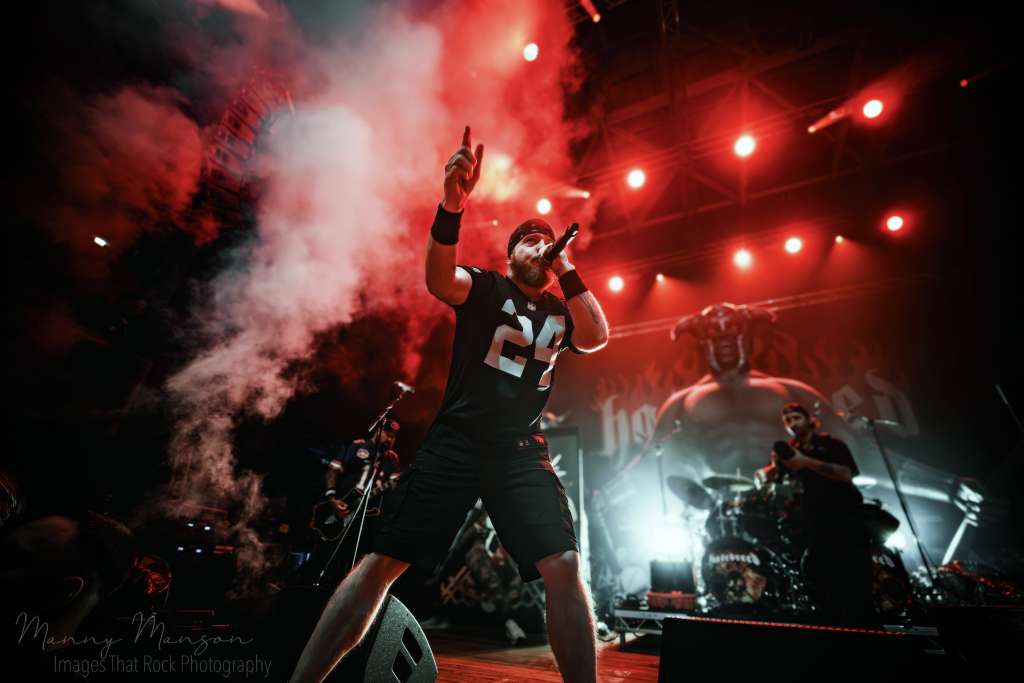
Then they appeared. Jasta front and centre, mic in hand, his presence a combination of predator and general, commanding the Hall’s with a single glance. Frank Novinec and Wayne Lozinak stood slightly to each side, guitars slung low, trading sharp, aggressive riffs that immediately sparked the pit into motion. Chris Schwartz on bass grounded the rhythm like a massive plinth, and Matt Byrne’s drums were thunder incarnate, every snare and kick punctuating the raw energy like artillery strikes.
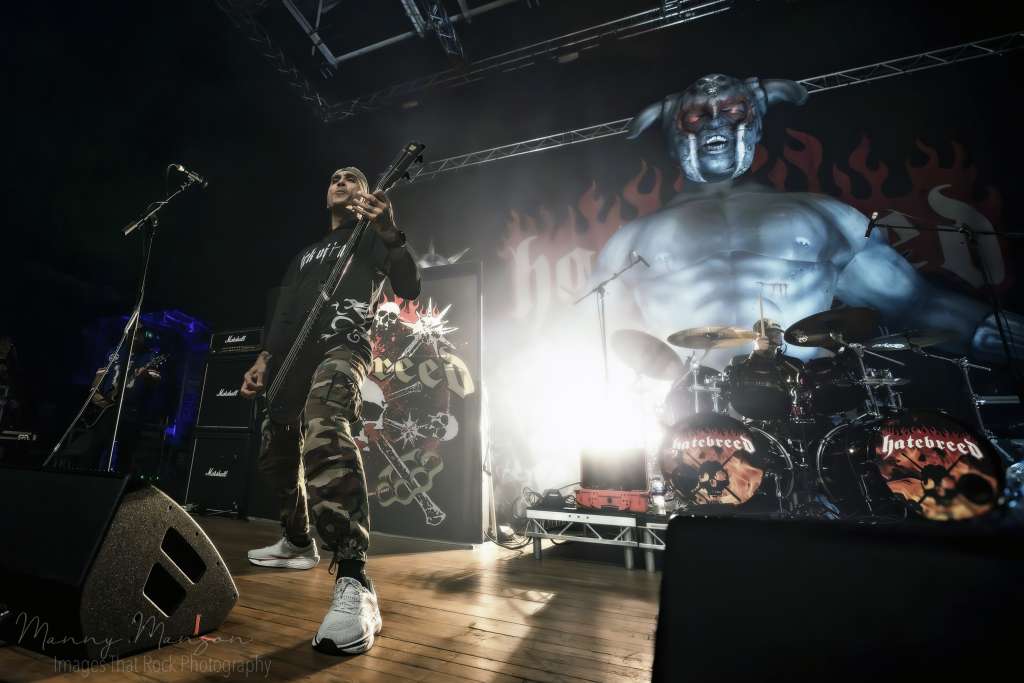
They opened with “I Will Be Heard”, (Perseverance), and the pit detonated instantly. Crowd surfers were thick and fast over the barrier, arms catching, bodies propelling others, creating waves of controlled chaos. Jasta prowled the front of the stage, leaning into the barrier, letting the audience roar the chorus while he spat the verses with venomous intensity. Every drum fill, every guitar accent was mirrored by the pit, creating a perfect feedback loop of aggression and release. “Make the Demons Obey” hit next, riffs precise, yet heavy with a groove that demanded movement. Jasta’s vocals shifted seamlessly from barked aggression to shouted anthems, mic technique raw and commanding. The pit surged with each breakdown; bodies flew over barriers, caught and lifted again, the floor vibrating with stomps. Frank and Wayne’s guitars interlocked during the bridges, harmonics stabbing through smoke, each note punctuated by Byrne’s relentless fills.
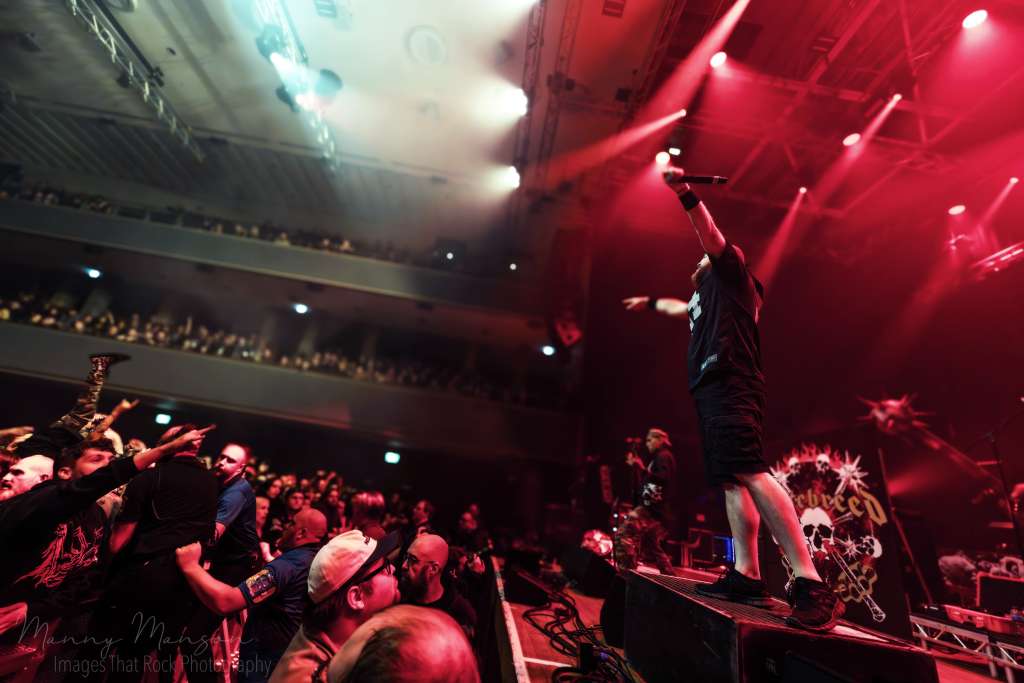
“To the Threshold”, (Supremacy), escalated the tension, the pit now a storm of bodies. Crowd surfers rotated midair, spinning into the pit, lifted by the motion of the crowd below. Jasta leapt across the stage, mic extended to let the crowd finish lines, then surged back into the centre, commanding attention. Lighting flickered in red and orange, highlighting faces contorted in sweat, aggression, and exhilaration. Every riff, every drum hit drove bodies, echoing off walls, filling the hall with kinetic energy. “Destroy Everything”, (Supremacy), tore in, drum fills crashing like thunder, basslines rippling through the floorboards, guitars slicing through the haze. Jasta moved like a predator, arms wide, voice cutting the air, letting the chorus explode from thousands of throats. The pit now felt almost ritualistic, a choreography of chaos, bodies flying, slamming, colliding in perfect rhythm with the music.
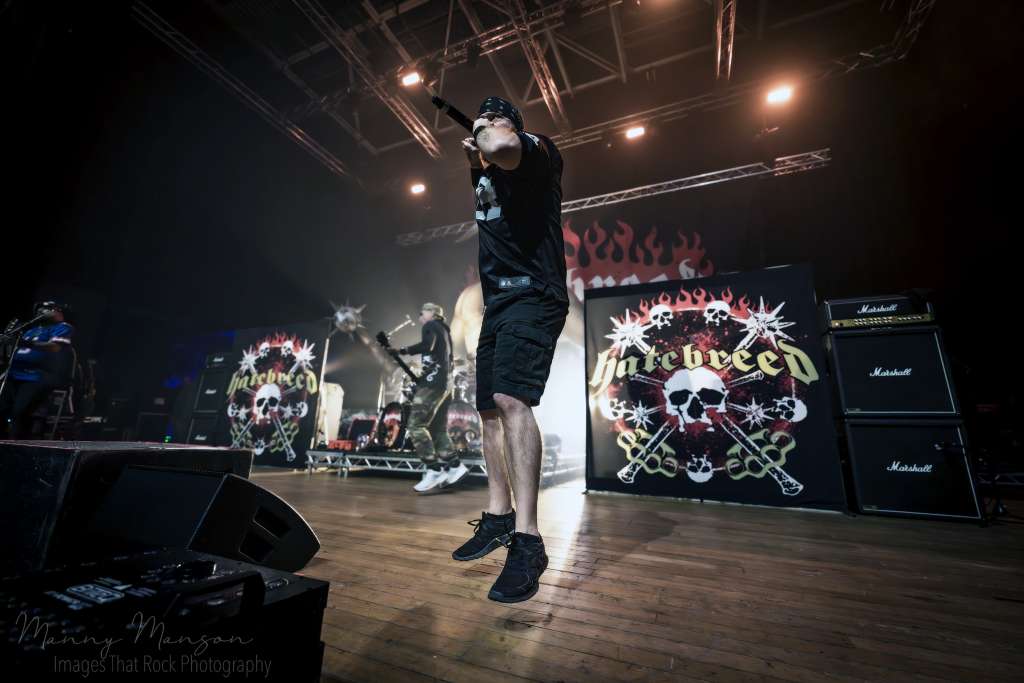
“This Is Now”, (The Rise Of Brutality), pushed the Hall’s further. smoke curling through coloured lights, red and orange streaking across every flailing arm and flying body. The pit was relentless, thick with surfers, the chaos almost physical in its density. Every riff by Frank and Wayne, every drum fill by Byrne, was mirrored by waves of motion in the audience. “Smash Your Enemies”, (Under The Knife), escalated to nearly unmanageable intensity. Crowd surfers sailed like projectiles over the barrier, sometimes landing mid-pit only to be lifted again in rhythm with the breakdowns. Jasta barked commands, letting the audience scream choruses back, pacing the energy like a master conductor. Guitars sliced through the thick smoke, bass hammered low, and every drum fill punctuated the chaos, escalating it further.
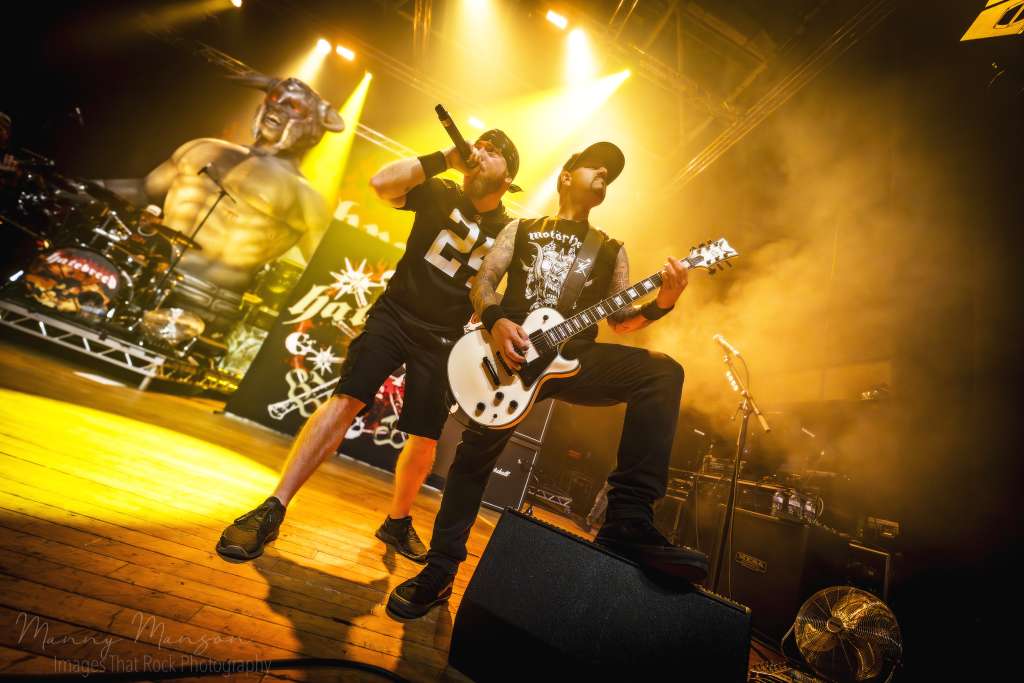
“Proven”, (Perseverance), brought a slight twist in tempo, a groove-heavy assault that let the pit breathe momentarily before exploding again. Crowd surfers were launched in thick waves, some somersaulting midair before being caught, others propelled forward by sheer momentum. Jasta’s stage prowling intensified, he moved from riser to riser, interacting with security and fans, guiding the energy like a general orchestrating a battlefield.
“Seven Enemies”, (The Concrete Confessional), brought pure brutality. Jasta moved like a predator, the pit surging in waves. Flames erupted intermittently, licking the risers, the red-orange glow illuminating flying bodies, clenched fists, and faces in ecstatic aggression. Byrne’s drum fills carved out pockets of chaos, Frank and Wayne’s harmonics slicing like knives through the haze, crowd surfers thick and continuous, carried in perfect timing by those below.
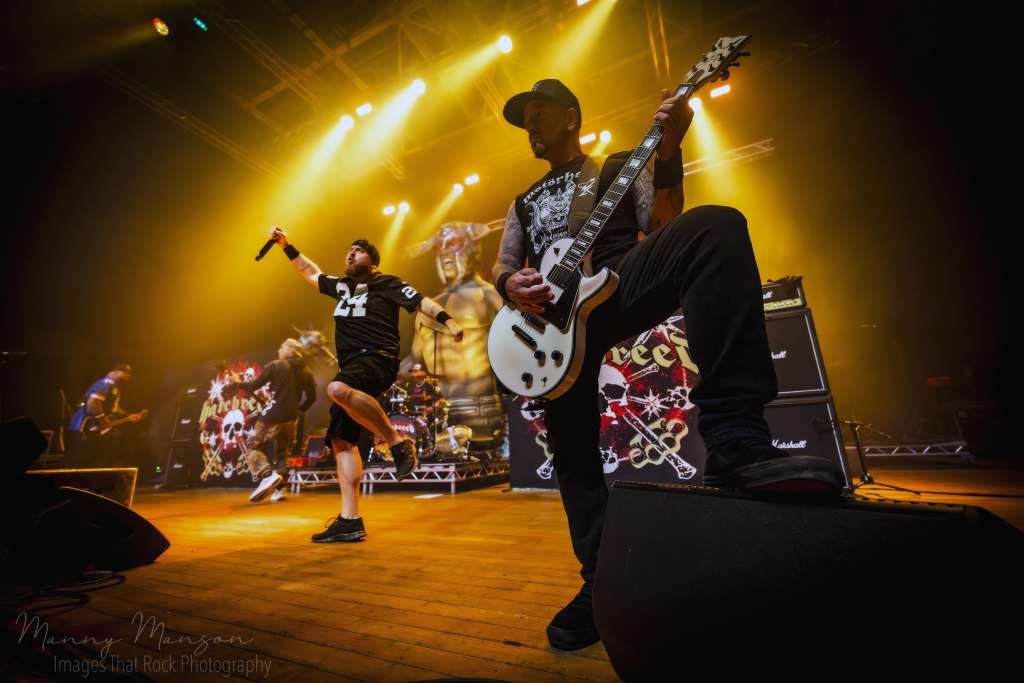
By “Perseverance”, (Perseverance), the stage and floor were fully alive. Jasta’s mic technique allowed him to guide the pit, dictating where bodies would surge next, leading breakdowns, letting the audience roar back every word. Frank and Wayne’s riffs cut sharply through smoke, Byrne’s snare hits punctuated the motion, and Beattie’s bass held the foundation under the chaos, a tether for the swirling energy.
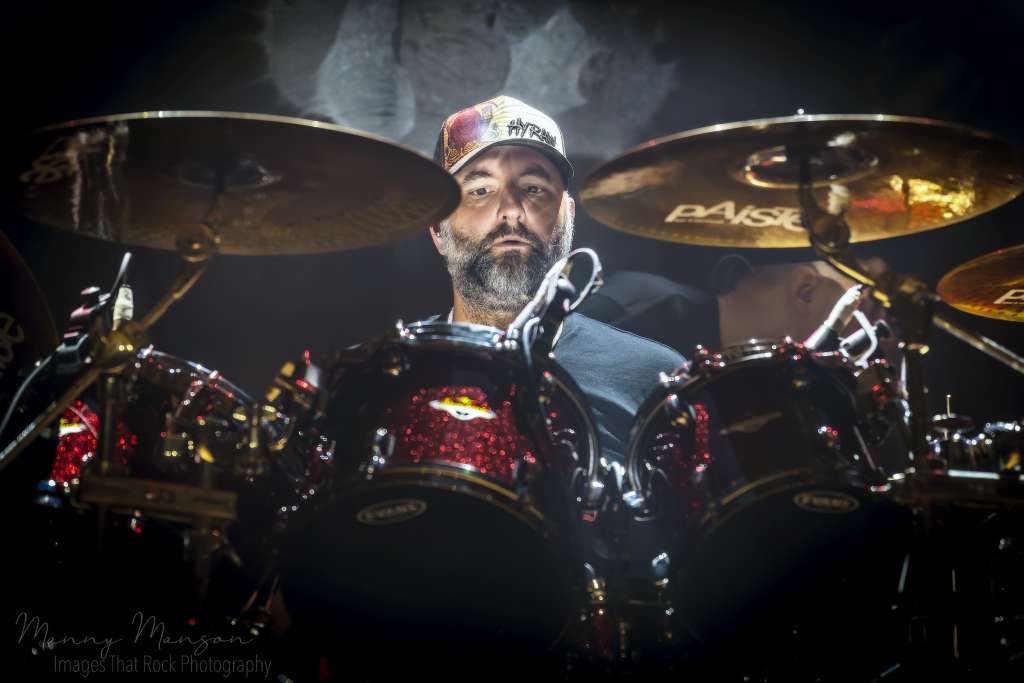
“In Ashes They Shall Reap” (Hatebreed) followed, heavy and unrelenting. The lighting flicked between white and red, spotlighting Jasta as he prowled the front, gesturing, inviting, demanding. The pit continued to churn; the intensity felt almost sacred, as if the band’s decades of surviving the hardcore world had distilled into these 4-5 minutes of ritualistic, shared release.
They eventually closed with “Looking Down the Barrel of Today”, (The Concrete Confessional), a final explosive statement. The pit was a hurricane of bodies, adrenaline, and sweat, crowd surfers thick and fast, arms catching and propelling, bodies twisting and colliding, a living organism in perfect sync with the music. Jasta prowled the stage, commanding, shouting, feeding off the collective roar, letting the final riffs explode into the hall.
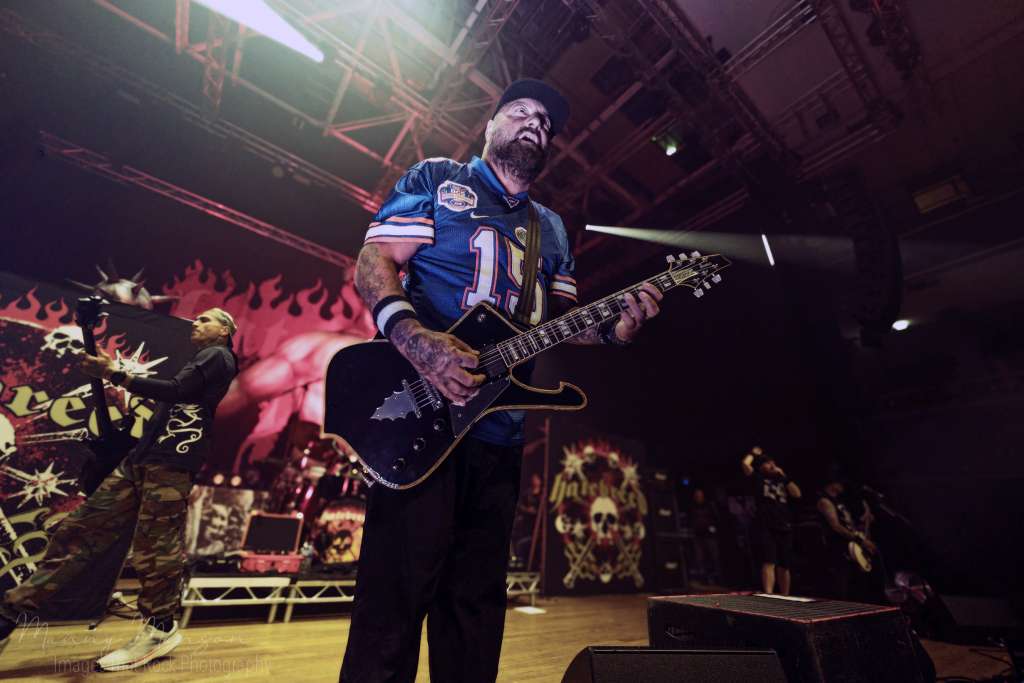
Flames rose behind the risers, smoke thick, lights flicking in red and orange, the chaos reaching its apex. When the final chord hit, the pit erupted one last time, a culmination of controlled chaos, leaving fans gasping, spent, exhilarated, and primed for the next storm, Killswitch Engage.
The last echoes of Hatebreed’s final chords hadn’t even faded before the Hall’s shifted. The air still thick with sweat and smoke, bodies still heaving from the pit, and then the first strains of Baba O’Riley, The Who’s iconic tape entrance song, crept through the speakers. The crowd erupted instantly, cheers and whistles bouncing off the walls, anticipation snapping like static in the air. Every fan knew what was coming: Killswitch Engage, the Massachusetts metalcore pioneers, stepping into the hall to claim the night.
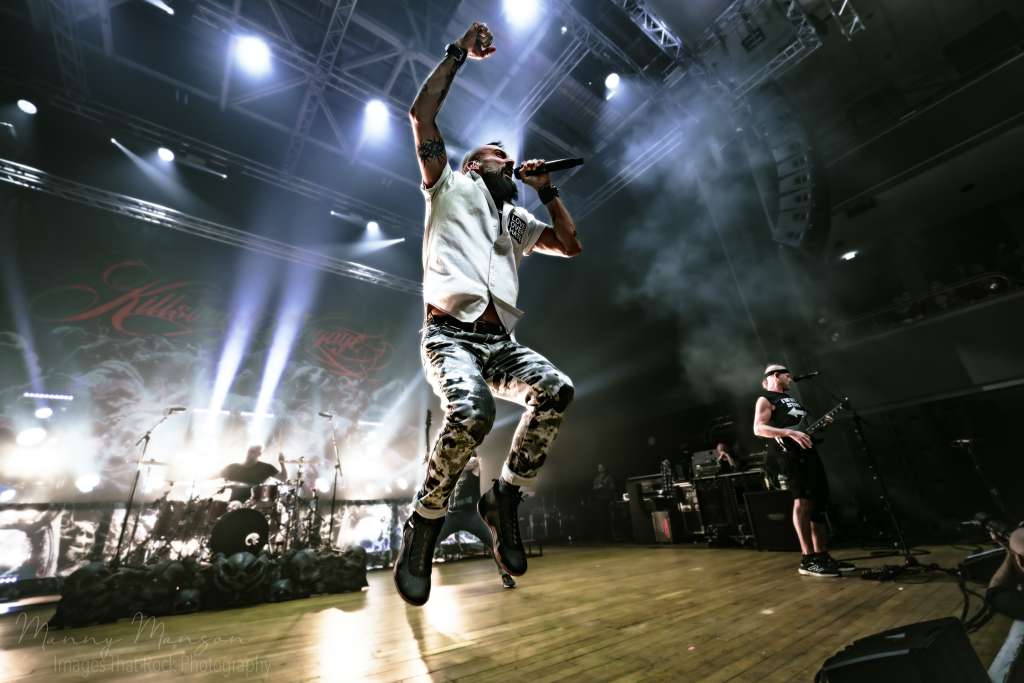
The lights dimmed and smoke began to curl from the edges of the stage. A massive white bridge lowered from the rafters, like some industrial monolith, and then they appeared. Jesse Leach at front, commanding, Adam Dutkiewicz and Joel Stroetzel on guitar, Mike D’Antonio’s bass anchoring, Justin Foley behind the kit. The band had formed in 1999 in Westfield, Massachusetts, and by now had decades of both tragedy and triumph behind them, albums like Alive or Just Breathing (2002) setting a blueprint, The End of Heartache (2004) cementing their legacy, and through This Consequence (2025), proving their sound only evolved without losing its soul. Jesse’s voice, clean and serrated, powerful yet human, cut through the hall immediately.
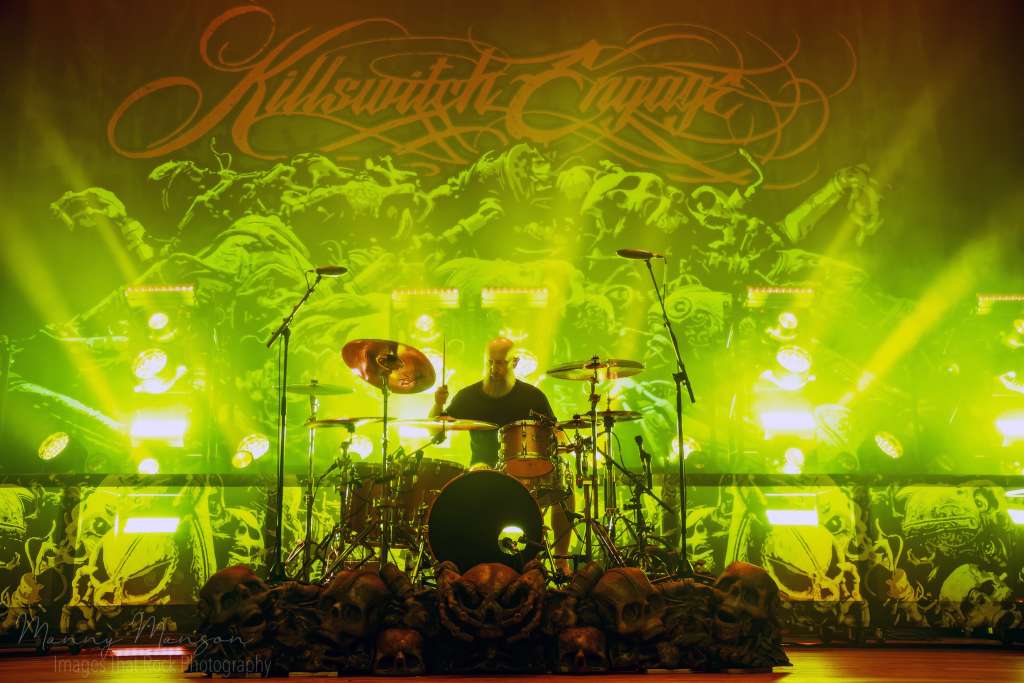
They opened live with “Strength of the Mind” (Incarnate, 2016), the riffs tight, the drums thunderous, the bass low and punchy. Smoke swirled, lights of orange and blue slicing through the haze, highlighting faces in the pit like carved statues. Crowd surfers were already flying over the barriers, a river of human bodies catching and passing each other, security moving like dancers in the chaos. Jesse prowled the stage, every word commanding, gesturing to the crowd as though pulling the energy out of their veins, threading it into the music. Adam and Joel were a study in synchronicity, riffs traded back and forth, solos leaping and spiralling, stage left and right communicating without words. “Rose of Sharyn” (The End of Heartache, 2004), followed, the first real fan-favourite singalong. The melodic yet crushing intro riff set off a surge of headbanging.
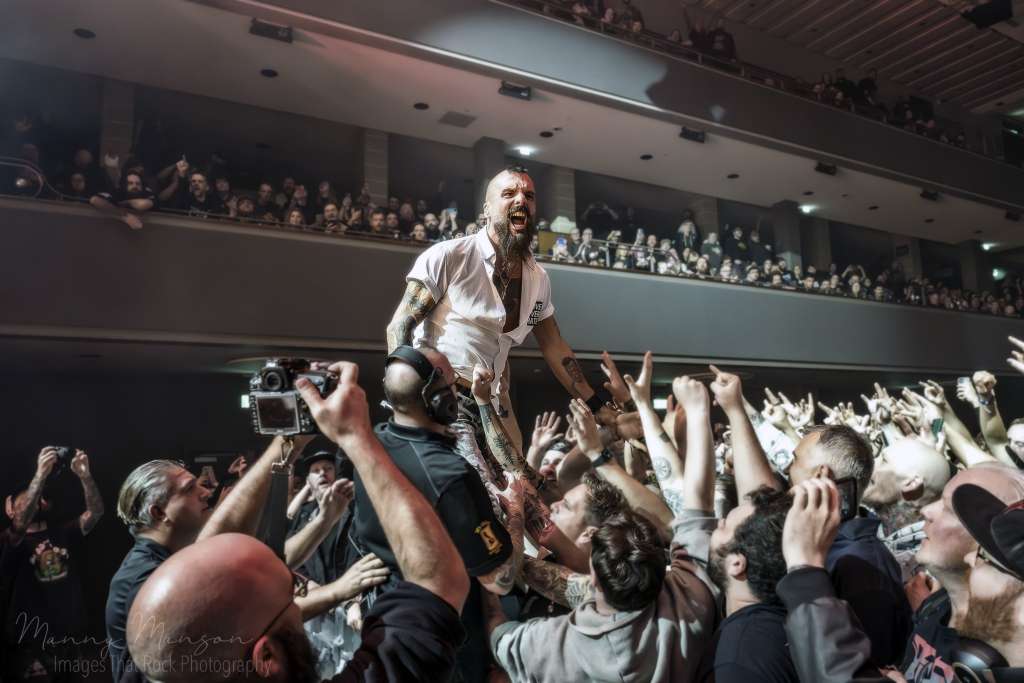
Fans screamed every lyric back at Jesse, bodies in the pit slamming into one another, crowd surfers somersaulting over barriers, arms flailing. The dual guitar harmonies in the verses cut through the smokie darkness like knives, every note precise, rehearsed but alive, teeth bared in aggression. Jesse moved from the main stage down to the edge, microphone in hand, stepping over the barrier and into the fans, letting them hold him up as the chorus sang out, this indeed helping to connecti the decades of KSE legacy with the raw present energy of their live show.
“Reckoning” (Killswitch Engage, 2009) pushed the tempo, aggressive yet melodic, guitar harmonics slicing through the smoke, the single kick drum of Justin Foley bellowed like a battering ram. The lights cut from red to white in flashes, highlighting the sweat-slicked faces of the pit, the desperation, the exhilaration.
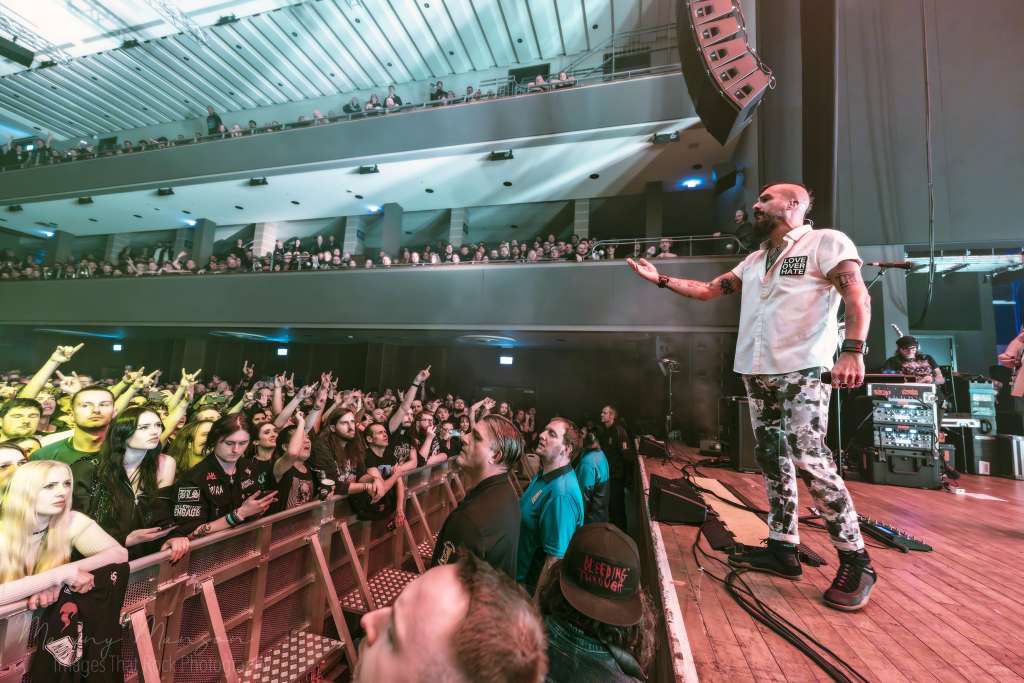
Jesse’s vocals shifted seamlessly between guttural growls and soaring clean lines, Adam’s guitar weaving tension, Joel backing with harmonics and rhythm precision, D’Antonio’s bass hammering the floor. Crowd surfers now were almost constant, vaulting over barriers in waves, thick and fast, (A new venue record surely), as the band fed off it, their performance intensifying with everybody that hit the floor. Then “Aftermath” (This Consequence, 2025), from the new album, slowed the pace slightly, an atmospheric breather but no less heavy. Jesse’s clean vocals soared above the swirling smoke, the lights softened into blue and green hues, creating a spectral effect over the Hall’s. The pit, while slightly calmer, moved as one unit, almost a living organism. The song’s layered textures, subtle melodic lines beneath crushing rhythms, gave space for fans to scream, breathe, catch up, before the band would launch into the next storm.
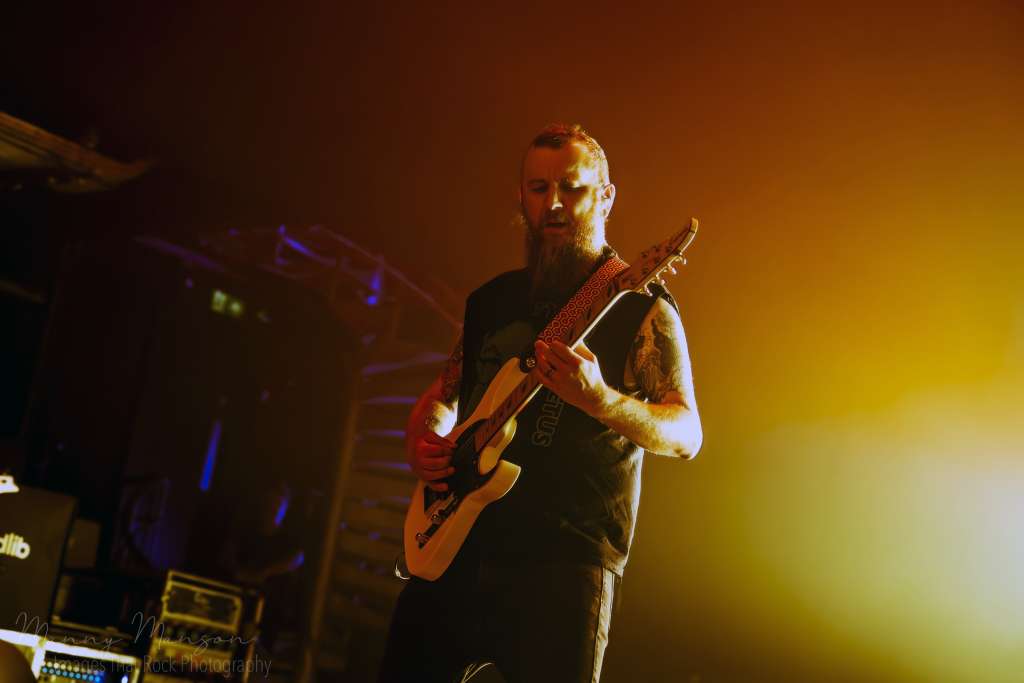
“Numbered Days” (Alive Or Just Breathing, 2002) and “This Is Absolution” (As Daylight Dies, 2006), a jump back to earlier years, hit back-to-back, heavy and relentless. Adam and Joel’s guitar interplay was mesmerizing; solos leapt like sparks into the hall, the riffing tight and sharp. Jesse moved constantly, up on risers, across the stage, leaning into the crowd, commanding their energy. The pit surged, body after body flying over the barriers, carried by sheer momentum and trust in security. “No End in Sight” (Disarm the Descent, 2013) and “Broken Glass” (This Consequence, 2025) brought moments of technical precision paired with crowd-driven chaos. Joel and Adam’s solos intertwined seamlessly, bass underpinning every note, drums hammering in perfect sync. Fans knew these moments were designed for communal energy — jumping, shouting, crashing, the hall vibrating in response. The lighting flickered red, orange, blue, and green, casting every head, arm, and hair whipping into sharp relief. Smoke thickening, coiling around the risers, the band’s silhouettes cutting through like giants emerging from a dystopian dreamscape.
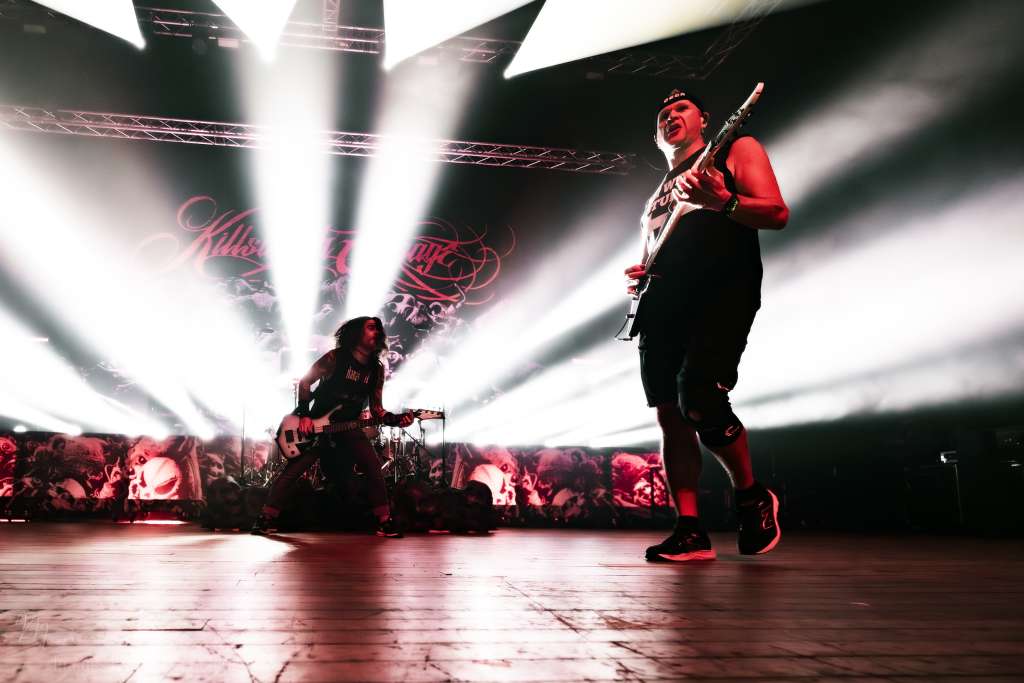
By “Hate by Design” (Incarnate, 2016) the Hall’s was a furnace. The energy erupting from the back stage during key riffs, synchronized to the drum hits and the chorus, firing the pit as sweat and hair flew in all directions. Jesse gestured for every fan to scream, and the crowd obeyed, a wall of voices, some singing, some shouting, some roaring in unison. Every movement on stage mattered, Adam and Joel’s guitars were almost in dialogue with the audience, riffs thrown, harmonics returned, rhythm and melody colliding. “Forever Aligned” (This Consequence, 2025) and “The Signal Fire” (Atonement, 2002) carried a bridge between the new material and classic KSE legacy. Fans screamed every chorus, bodies rising and falling, waves of crowd surfers thick and relentless. Jesse leaned back to let the audience finish lines, letting the energy build naturally, then striking back with full force. Sweat, smoke, lights, it all combined into a sensory overload that was both musical and physical.
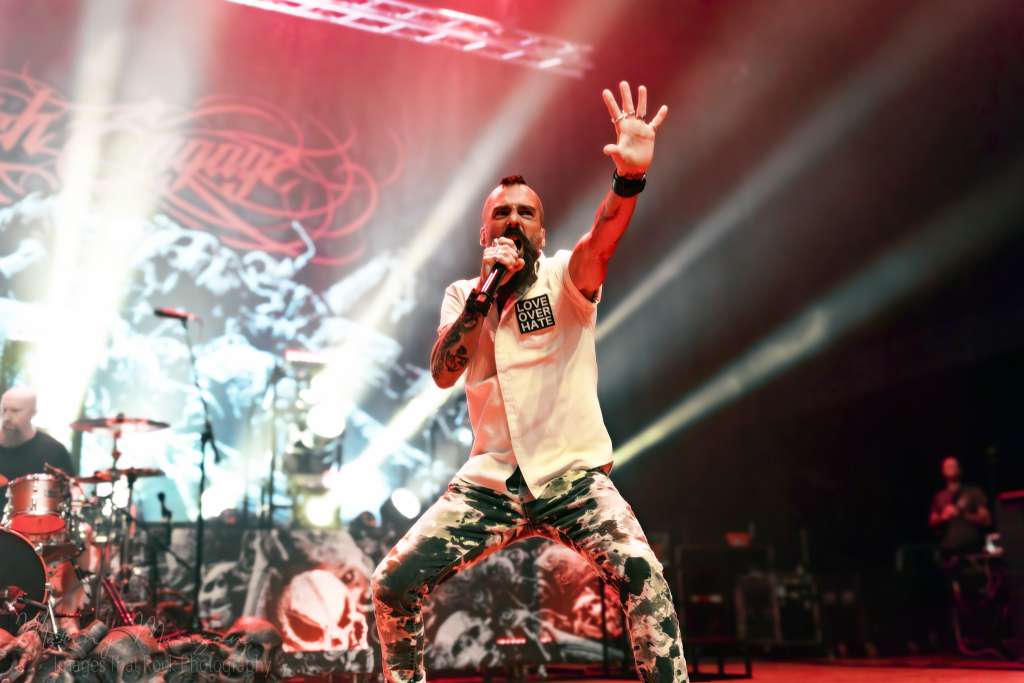
“I Believe” (This Consequence, 2025) and “A Bid Farewell” (The End Of Heartache, 2004) brought a mix of nostalgia and modern energy. The pit pulsed, the band’s energy mirrored it perfectly, and the Hall’s became a single, living organism. Jesse’s vocals soared, harmonising with the crowd at times, Adam and Joel traded solos, D’Antonio’s bass a low, seismic rumble beneath it all, Foley’s drums, ever relentless. Every break, every build, was executed with surgical precision, yet the chaos felt organic, alive. Then the band shifted into “In Due Time” (Disarm The Descent, 2013) and “This Fire” (As Daylight Dies, 2006), more high-octane tracks, full of tension, riffs slicing the air, flames erupting higher now, fans roaring, the pit unrelenting. The smoke hung heavy, the lights jagged and wild, Jesse moving like a conductor, pulling every ounce of energy from the floor.
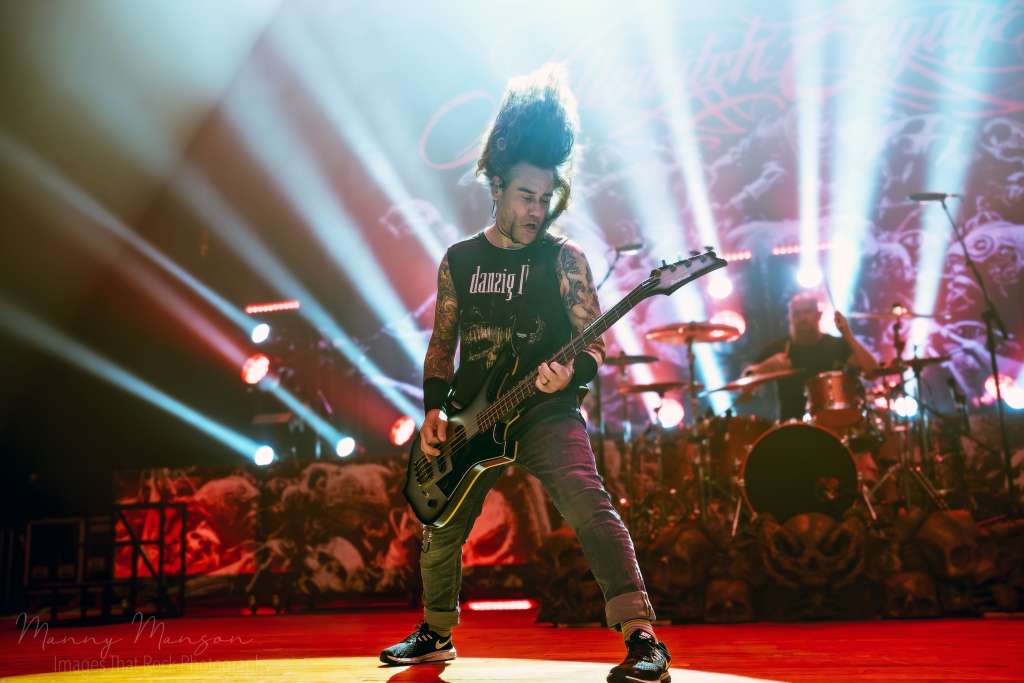
“My Curse” (As Daylight Dies, 2006) hit like a tidal wave. The older fans sang every word, younger fans learned on the fly, the chorus swelling into an almost unbearable collective roar. The pit was at maximum saturation, crowd surfers sailing like projectiles, bodies tangled and lifted, arms flailing in pure ecstasy. The guitars harmonised perfectly, every note cut through the haze, drums like artillery, bass like the pulse of the Earth. “The End of Heartache” (The End of Heartache, 2004) followed, the ultimate legacy closer. The band’s history was unmistakable here, the iconic riff, the soaring chorus, Jesse’s voice cutting clean and guttural as needed, Adam and Joel trading leads, Mike and Justin holding the foundation. Flames erupted behind the risers in synchronized bursts, smoke coiled into columns, coloured lights slicing through the haze, highlighting every face, every motion. Crowd surfers continued to fly over the barrier, thick and fast, security moving like choreographed dancers amidst the chaos.
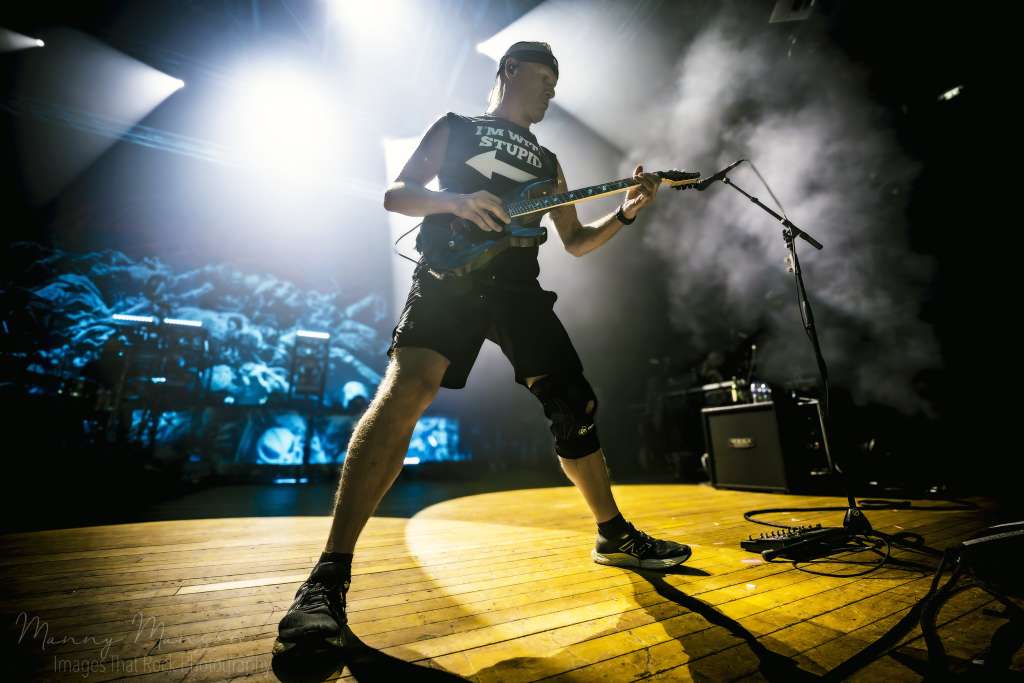
Finally, “My Last Serenade” (Alive or Just Breathing, 2002) closed the night. Jesse strode to the front of the stage, arms wide, taking in the roar of thousands, letting the echo of the pit fill every corner. Adam and Joel delivered their final dual solos, Mike’s bass thumped in the chest, Justin’s drums fired like a cannon, and the crowd hit their apex, tall, bright, synchronised with the last chord. When it ended, silence held for a heartbeat before the crowd erupted into a deafening roar. Sweat, smoke, heat, adrenaline, the hall was alive, vibrating with the memory of everything just endured. The band raised their arms in acknowledgment, sweat dripping, smiles fleeting but proud, before finally retreating offstage.
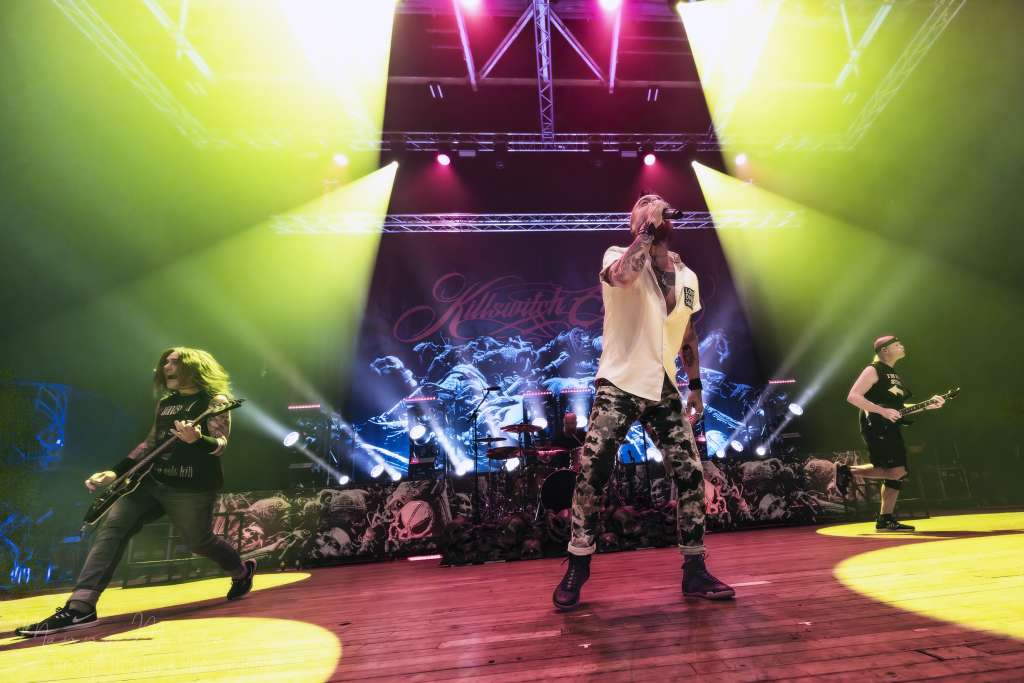
It was a finale worthy of every second leading up to it, every band before, building tension, every riff, every scream, every wave of crowd surfers feeding into this perfect storm. Killswitch Engage didn’t just play; they dominated, curated chaos, orchestrated ecstasy, and left a hall full of fans stunned, spent, and exultant. That is how to spend your ‘Hump-Day’.







